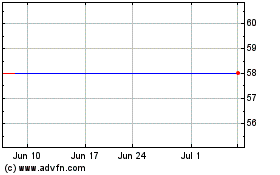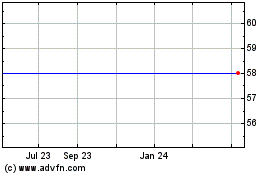By Shalini Ramachandran And Brent Kendall
The U.S. Justice Department is investigating whether Comcast
Corp.'s business practices in the $5 billion cable
advertising-sales market violate federal antitrust law, according
to a document reviewed by The Wall Street Journal.
The document, known as a civil investigative demand, indicates
the department's antitrust division is probing whether Comcast's
cable ad sales, as well as its deals to represent rival pay TV
providers' ad sales, are hindering competition.
The investigation is focused on "monopolization or attempted
monopolization" of the "spot" cable ad sales business in geographic
areas where Comcast offers service, according to the document. The
document also indicates the government is examining whether
Comcast's ad deals with pay TV rivals are an unlawful restraint of
trade.
The Justice Department is requesting additional information from
companies in the market, including Comcast, according to people
familiar with the matter. The scope of the government's probe,
which appears to be at an early stage, isn't clear.
The Justice Department declined to comment. Comcast said it
plans to cooperate fully with the Justice Department's inquiry.
Comcast said the advertising market is "robustly competitive"
and local cable advertising only accounts for about 7% of local ad
sales because of competition with other media like radio and
broadcast TV.
Antitrust officials are examining a relatively obscure
underbelly of the $70 billion television advertising market.
As part of their carriage agreements with pay TV providers like
Comcast and AT&T's DirecTV, cable channels typically set aside
about two minutes of every hour for the operators to sell
advertising. National, regional and local advertisers bid for
commercial time in this "spot" cable ad market.
Spot cable ads gives marketers--from local furniture stores to
area politicians to national brands like General Motors--the
ability to target a preferred geography, which can be more
efficient and cheaper than buying advertising on a national scale.
That is how, for example, a local real-estate firm can air a
commercial on ESPN during Monday Night Football in a particular
local market without having to pay a steep price for a nationwide
ad.
Comcast, Time Warner Cable Inc. and third-party firms like
Viamedia Inc. and Prime Media Productions offer services to help
smaller pay TV providers sell, bill and insert ads into
programming. This is the market for so-called representation
services that is part of the Justice Department's probe.
Comcast Spotlight, owned by Comcast, is the largest U.S. cable
ad sales representation firm. Comcast's sales team covers about 35
million households, bringing in an estimated 48.1% of gross cable
advertising sales in 2014, according to SNL Kagan.
The Justice Department has scrutinized the cable industry
throughout President Barack Obama's administration, and the probe
doesn't necessarily mean the government will attempt any
enforcement action.
It is unclear what sparked the Justice Department's current
probe. But Comcast's influence over this marketplace came up during
the government's review of its ill-fated attempt to buy Time Warner
Cable.
Rival pay TV providers including CenturyLink and RCN, and
competing cable ad sales representation firms like Viamedia, raised
concerns that the merger would have given the cable giant control
over the spot cable ad market, hindering their ability to compete
and potentially making it difficult for small businesses to
advertise. Documents filed by those companies with the Federal
Communications Commission during the merger review paint a picture
of a marketplace that was already being dominated by Comcast.
Cable ads are sold in different ways, depending on whether an
advertiser is national, regional or local.
For national advertisers like General Motors, the primary way to
buy spot cable advertising across cable, phone and satellite TV
distributors at a one-stop shop is through a firm called NCC Media
LLC, which is majority owned by Comcast.
Regional advertisers buy through "interconnects," which are
sales and technology cooperatives made up of pay TV providers in a
particular market. The dominant pay TV provider in a given market
makes deals with advertisers on behalf of the other interconnect
members. As the largest cable operator, Comcast manages
interconnects in 26 of the top 50 TV markets in the country.
Local advertisers like car dealerships can buy directly through
a pay TV provider or through a cable ad sales representation firm
like Viamedia.
In recent years, Comcast started requiring pay TV rivals who
wanted to be part of a Comcast-managed interconnect to use
Spotlight as opposed to a third-party firm like Viamedia, according
to competitors' filings during the merger review. That reversed a
long-standing practice for interconnects to grant access to all
parties, they said.
For instance, Viamedia said Comcast refused to renew its
agreement with two Comcast-controlled interconnects in 2012,
blocking Wide Open West and RCN from the interconnects unless they
agreed to only be represented by Comcast Spotlight, instead of
Viamedia.
In a December filing, RCN said it wasn't comfortable having "its
largest and most formidable rival as its representative in the spot
cable market, " given that would require sharing sensitive business
information with Comcast.
While Comcast offered Viamedia a deal to re-enter its
interconnects, Viamedia refused because it said Comcast was asking
for a 50% higher fee than two years earlier. Wide Open West and RCN
recently struck deals to work with Comcast Spotlight starting next
year. Comcast defended its practices, saying in a filing during the
merger review that "there is nothing anticompetitive about a firm
electing not to do business with one of its competitors."
In a statement Tuesday, Comcast said "interconnects increase
efficiency and help keep costs down for advertisers" and are "good
for advertisers and consumers."
Steven Perlberg contributed to this article
Subscribe to WSJ: http://online.wsj.com?mod=djnwires
(END) Dow Jones Newswires
November 24, 2015 13:06 ET (18:06 GMT)
Copyright (c) 2015 Dow Jones & Company, Inc.
Comcast (NASDAQ:CMCSK)
Historical Stock Chart
From Oct 2024 to Nov 2024

Comcast (NASDAQ:CMCSK)
Historical Stock Chart
From Nov 2023 to Nov 2024
